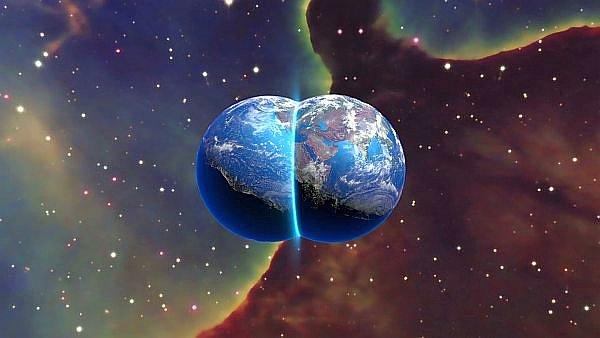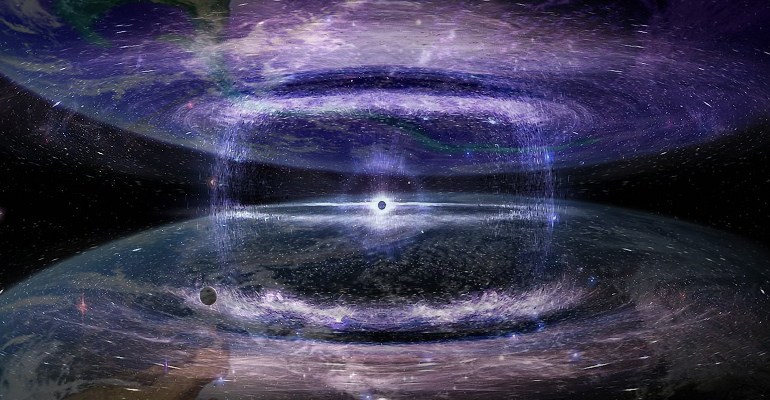Unveiling the Multiverse: Captivating Realms of Possibility in Parallel Universes
Introduction:
The concept of parallel universes, or multiverses, has long fascinated scientists, philosophers, and storytellers alike. The idea that there could be other realms, diverging from our own reality, has sparked imaginative exploration and intriguing theories across various disciplines. In this article, we will delve into the captivating realm of parallel universes, examining the scientific hypotheses, philosophical implications, and how this concept has inspired creative works in literature and popular culture.
Theoretical Foundations:
In the realm of theoretical physics, the notion of parallel universes is often associated with the concept of the multiverse. One prominent idea is the "Many-Worlds Interpretation" of quantum mechanics, proposed by Hugh Everett III in the 1950s. According to this interpretation, every quantum event results in the creation of multiple parallel universes, where all possible outcomes of that event unfold. This theory challenges our traditional understanding of reality and suggests that every decision we make could lead to a branching of universes.
String theory, a framework attempting to reconcile quantum mechanics and general relativity, also gives rise to the possibility of a multiverse. In this context, different vibrational states of string particles could manifest as distinct universes with varying physical constants and laws.
Philosophical Implications:
The existence of parallel universes raises profound philosophical questions about the nature of reality, free will, and the fundamental structure of the cosmos. Philosophers ponder whether the concept of parallel universes supports or challenges traditional notions of determinism and the role of chance in our lives. The idea that all possible outcomes of our actions exist simultaneously prompts contemplation on the nature of choice and the paths not taken.
Literary and Cinematic Explorations:
Parallel universes have served as fertile ground for creative minds in literature and film. Classic works such as H.G. Wells' "The Time Machine" and Philip K. Dick's "The Man in the High Castle" explore alternate realities and their impact on characters' lives. More recently, TV series like "Stranger Things" and films like "Inception" and "The Matrix" have captivated audiences with intricate narratives involving parallel worlds.
The concept of parallel universes continues to be a source of fascination and inspiration across scientific, philosophical, and artistic realms. While its scientific validity is still a subject of debate, the idea of multiple realities challenges our understanding of the universe and enriches our imaginative landscapes. Whether through the lens of theoretical physics or the canvas of storytelling, parallel universes invite us to question the boundaries of reality and embark on a journey into the infinite possibilities of existence.
The concept of parallel universes, a cornerstone of speculative science and philosophical inquiry, has gained prominence in theoretical physics. This article aims to explore the scientific foundations of parallel universes, focusing on the key theories that underpin this captivating concept and the ongoing discussions within the scientific community.
Theoretical Frameworks:
Many-Worlds Interpretation (MWI):
The Many-Worlds Interpretation, proposed by physicist Hugh Everett III in 1957, suggests that every quantum event results in a branching of the universe. In simple terms, all possible outcomes of a quantum measurement exist simultaneously in separate, non-communicating branches. This theory challenges traditional notions of collapse in quantum mechanics and implies the existence of countless parallel universes.
String Theory and the Multiverse:
String theory, a theoretical framework aiming to unify quantum mechanics and general relativity, introduces the idea of a multiverse. According to string theory, the universe is composed of tiny, vibrating strings. Different vibrational states of these strings could give rise to multiple universes, each with its own set of physical laws and constants. This approach provides a unique perspective on the potential diversity of parallel universes.
Bubble Universes and Inflationary Cosmology:
Inflationary cosmology suggests that the early universe underwent a rapid expansion phase. This theory proposes the existence of "bubble universes," regions with different physical properties existing alongside our own universe. The idea is that during the inflationary epoch, various bubbles emerged, each representing a distinct universe with its own unique characteristics.
Quantum Entanglement and Non-locality:
Quantum entanglement, a phenomenon where particles become correlated in such a way that the state of one particle directly influences the state of another, has led some physicists to explore the possibility of non-local connections between parallel universes. The entanglement of particles across vast distances raises questions about the nature of spacetime and the potential interconnectedness of parallel realms.
Scientific Challenges and Debates:
While these theoretical frameworks offer intriguing possibilities, the scientific community continues to grapple with challenges and debates surrounding the concept of parallel universes. Some scientists question the testability and empirical evidence for these theories, emphasizing the need for experimental validation. Others argue that the mathematical elegance and consistency of these frameworks warrant serious consideration.
The scientific exploration of parallel universes remains a dynamic and evolving field within theoretical physics. The Many-Worlds Interpretation, string theory, inflationary cosmology, and quantum entanglement collectively contribute to a multidimensional understanding of the cosmos. As advancements in experimental techniques and theoretical refinement progress, the quest to unravel the mysteries of parallel universes promises to further deepen our comprehension of the fundamental nature of reality.
The exploration of parallel universes, while primarily rooted in theoretical physics, has sparked a growing interest in scientific circles. This article delves into the ongoing scientific research endeavors aimed at unraveling the mysteries of parallel universes, examining the cutting-edge experiments and observations conducted by physicists in their quest for empirical evidence.
Experiments and Observations:
Quantum Entanglement Experiments:
- Some researchers propose that studying quantum entanglement on a larger scale could offer insights into the possible existence of parallel universes. Experiments involving entangled particles separated by considerable distances aim to explore non-local connections and their implications for the fabric of spacetime.
Cosmic Microwave Background (CMB) Studies:
- Scientists analyze the cosmic microwave background radiation, remnants of the early universe, to uncover potential imprints left by interactions with other universes. Variations in the CMB could provide clues about the existence of neighboring parallel universes and their potential influence on our own cosmic microwave background.
Particle Collider Experiments:
- Experiments conducted at particle colliders, such as the Large Hadron Collider (LHC), aim to probe the fundamental nature of reality. Researchers explore the possibility of hidden dimensions and parallel universes by examining particle behavior and interactions at energies previously unattainable.
Gravitational Wave Observations:
- The detection of gravitational waves has opened new avenues for studying the cosmos. Scientists are exploring whether these ripples in spacetime could be indicative of interactions between our universe and parallel realms. Ongoing gravitational wave observatories continue to refine their techniques to capture even fainter signals.
Multiverse Predictions from String Theory:
- String theory, a framework attempting to unify quantum mechanics and general relativity, predicts the existence of a multiverse. Researchers explore the implications of string theory, aiming to identify unique signatures or anomalies in our universe that could be attributed to interactions with parallel realms.
Challenges and Future Directions:
Despite these ambitious efforts, the quest to discover parallel universes faces significant challenges. Experimental limitations, the need for advanced technologies, and the interpretation of results remain major hurdles. The interdisciplinary nature of the research involves collaboration between physicists, astronomers, and cosmologists to develop comprehensive models that can be tested and refined.
As the scientific community pushes the boundaries of exploration, the pursuit of parallel universes stands as a captivating frontier. While empirical evidence remains elusive, the innovative experiments and observations conducted by researchers contribute to a deeper understanding of the cosmos. The quest for parallel universes reflects the collective curiosity of humanity as we endeavor to unravel the mysteries of existence.
The concept of parallel universes, once confined to the realms of theoretical physics and speculative philosophy, continues to evolve as scientific inquiry progresses. This article explores the potential future role of parallel universes, examining how advancements in our understanding of these alternate realms could influence various aspects of science, technology, and society.
Advancements in Quantum Computing:
- As quantum computing technologies advance, researchers speculate that the exploration of parallel universes could become a tangible aspect of computation. Quantum computers may potentially simulate complex scenarios involving parallel universes, offering unprecedented insights into the nature of reality.
Interdimensional Communication and Information Exchange:
- Theoretical physicists are exploring the concept of information transfer between parallel universes. If proven possible, this could revolutionize communication technologies, allowing for interdimensional data exchange with profound implications for information processing and storage.
Technological Applications of Multiverse Theories:
- The potential existence of a multiverse, as suggested by theories like string theory, might inspire the development of technologies harnessing principles from parallel universes. Innovations in materials, energy, and even transportation could arise from a deeper understanding of the interconnectedness of universes.
Philosophical and Ethical Implications:
- The recognition of parallel universes could challenge existing ethical frameworks and philosophical paradigms. Concepts such as determinism, free will, and moral responsibility may undergo reevaluation as humanity grapples with the implications of living in a multiverse.
Impact on Astrophysics and Cosmology:
- Future telescopes and observatories may be designed with the explicit goal of detecting signals or anomalies indicative of interactions between our universe and parallel realms. The discovery of observational evidence for parallel universes could reshape our understanding of the cosmos.
Integration with Artificial Intelligence (AI):
- The exploration of parallel universes might influence the development of artificial intelligence. AI systems equipped with insights from multiverse theories could approach problem-solving and decision-making in novel ways, potentially enhancing their cognitive capabilities.
Space Exploration and Parallel Realms:
- Future space missions may incorporate the possibility of encountering alternate realities. Exploration beyond our solar system could involve considerations for the existence of parallel universes, prompting scientists and astronauts to anticipate unique challenges and phenomena.
The future role of parallel universes holds promise for groundbreaking advancements in science, technology, and our understanding of the universe. While the exploration of these realms is currently speculative, ongoing research and technological progress may usher in an era where the concept of parallel universes transforms from theoretical abstraction to practical application, influencing diverse fields and reshaping our perception of reality.
The idea of parallel universes, once relegated to the fringes of scientific speculation and science fiction, has gradually permeated public consciousness. This article delves into the complex landscape of public perceptions surrounding the existence of parallel universes, exploring the interplay between scientific theories, fictional narratives, and the broader beliefs of society.
The Rise of Parallel Universes in Popular Culture:
- The prevalence of parallel universes in literature, movies, and television has significantly contributed to shaping public perceptions. From iconic series like "Stranger Things" to cinematic universes like "The Matrix," these narratives often depict parallel universes as mysterious realms with profound implications.
Scientific Influence on Public Understanding:
- Despite being rooted in theoretical physics, the concept of parallel universes has found its way into mainstream discourse. Scientific explanations, such as the Many-Worlds Interpretation and string theory, have influenced how the public conceptualizes these alternate realities.
Media Portrayals and Misconceptions:
- Media representations, while captivating, can sometimes lead to misconceptions. The intricacies of theoretical physics may be oversimplified or exaggerated, contributing to a blend of fascination and confusion among the general public regarding the nature of parallel universes.
Impact on Belief Systems:
- Parallel universes have sparked discussions about the nature of reality, free will, and destiny. The coexistence of multiple realities challenges traditional beliefs, prompting individuals to reconsider their understanding of the universe and their place within it.
Cultural Variances in Acceptance:
- The acceptance of parallel universes varies across cultures and regions. While some societies readily embrace these concepts, others may find them at odds with religious or cultural beliefs. Understanding these cultural nuances is crucial in assessing the overall societal perception.
Educational Initiatives and Public Awareness:
- Educational efforts play a crucial role in shaping public perceptions. Scientific outreach programs, documentaries, and popular science books contribute to a more informed public discourse, fostering an appreciation for the complexities of theoretical physics and the exploration of parallel universes.
The Internet and Spread of Beliefs:
- The internet has become a hub for discussions on parallel universes, enabling the rapid spread of information, both accurate and speculative. Online communities and social media platforms serve as forums where diverse perspectives on the existence of parallel universes converge.
Conclusion:
Public perceptions of the existence of parallel universes are multifaceted, influenced by a dynamic interplay of scientific discoveries, fictional narratives, and cultural beliefs. As discussions on this topic continue to evolve, fostering a balanced understanding that acknowledges both the scientific foundations and cultural implications will be crucial in navigating the complex terrain of societal beliefs regarding parallel universes.
Source:
https://www.dasdas.com.tr/parallel-universe/
https://en.wikipedia.org/wiki/Parallel_universes_in_fiction
https://xmediaartmuseum.com/parallel-universe/
https://science.howstuffworks.com/science-vs-myth/everyday-myths/parallel-universe.htm
https://www.forbes.com/sites/startswithabang/2016/11/18/is-there-another-you-out-there-in-a-parallel-universe/
https://now.northropgrumman.com/parallel-universe-theory-what-are-the-chances-of-another-you







































